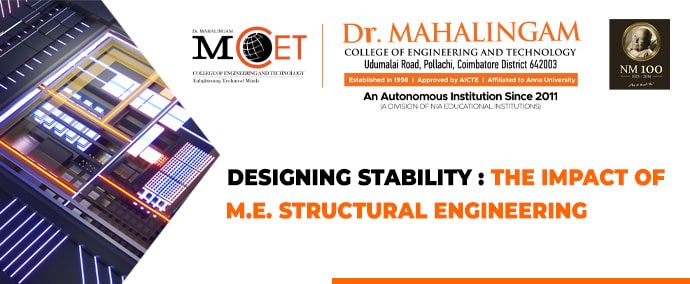“Picture a skyscraper soaring into the clouds, a bridge gracefully spanning a river, or a stadium filled with roaring fans. These awe-inspiring structures are made possible by the collaborative efforts of architects, construction workers, and, of course, structural engineers. While architects envision the grand design and construction workers bring it to life, structural engineers ensure that these creations are not only visually stunning but also safe and stable”.
In the world of architecture and construction, structural engineering lays the foundation for success. It deals with the science of designing and analyzing structures to ensure they can withstand the forces they will encounter throughout their lifespan. However, within the realm of structural engineering lies a specific field that has transformed the design process for the better: M.E. structural engineering.
Understanding M.E. Structural Engineering
Definition and Scope
M.E. structural engineering involves the integration of mechanical engineering principles into the design process to improve structural efficiency, safety, and performance. It encompasses various aspects, such as load analysis, material selection, and predicting the behavior of structures under different conditions.
Advantages and Benefits
The incorporation of mechanical engineering principles in structural engineering offers numerous advantages over traditional methods. One significant benefit lies in the ability to optimize the structural design, leading to improved efficiency and reduced material consumption. By leveraging M.E. techniques, engineers can design structures that achieve the same level of stability but with fewer resources.
This optimization not only contributes to cost savings but also reduces the environmental impact of construction projects. Through careful material selection and reduction of waste, M.E. structural engineering supports sustainable development practices.
The Revolutionary Impact of M.E. Structural Engineering
In an era where sustainability is a global concern, M.E. Structural engineering has emerged as a crucial tool for designing sustainable structures. By incorporating mechanical engineering principles, designers can create energy-efficient buildings that reduce the reliance on non-renewable resources, minimize waste, and enhance occupant comfort.
M.E. techniques enable engineers to implement passive heating and cooling systems, utilize energy-efficient materials, and incorporate smart building automation. These innovations contribute to reducing the environmental footprint of buildings while improving occupant well-being and comfort.
Innovations in Structural Analysis and Modeling
The field of structural analysis and modeling allows engineers to accurately predict the behavior of structures under various loading conditions. Advanced software tools and computer simulations are now standard in M.E. structural design, enabling engineers to simulate and optimize structural performance.
By utilizing M.E. principles in structural analysis, engineers can identify potential vulnerabilities and design structures that offer maximum strength while maintaining safety margins. These advancements have significantly improved the precision and reliability of structural design, minimizing the risk of structural failures.
Enhancing Structural Resilience
Natural disasters, such as earthquakes and hurricanes, can have devastating consequences for structures and, more importantly, human lives. M.E. structural engineering plays a vital role in enhancing the resilience and survivability of structures when faced with extreme events.
The integration of M.E. principles allows engineers to design earthquake-resistant buildings, hurricane-proof structures, and resilient infrastructure systems. These designs incorporate features like reinforced foundations, flexible structural systems, and dynamic dampers to absorb and dissipate forces during an event. The result are structures that can withstand and minimize damage during catastrophic events, saving lives and resources.
The Future of M.E. Structural Engineering
The future of M.E. structural engineering looks promising as technology continues to advance at a rapid pace. Emerging technologies, such as artificial intelligence and machine learning, hold immense potential for optimizing structural design and improving efficiency.
These advancements enable engineers to automate various aspects of design and analysis, streamlining the construction process while maintaining safety and reliability. Virtual reality and augmented reality also offer new possibilities for engineers to visualize and interact with structures, facilitating better collaboration and decision-making throughout the design and construction phases.
Integrating Sustainability and Efficiency
As the world faces the challenges of climate change and resource limitations, sustainability and efficiency become increasingly important in structural design. M.E. structural engineering will continue to play a vital role in developing innovative solutions that address these challenges.
Advancements in sustainable materials, such as bio-based composites and recycled materials, offer opportunities for M.E. engineers to design structures with reduced environmental impact. Additionally, optimizing energy use through intelligent building systems, renewable energy integration, and improved insulation techniques will contribute to creating more sustainable and energy-efficient structures.
Designing stability is at the core of structural engineering, and M.E. Structural Engineering has revolutionized the way we achieve it. By incorporating mechanical engineering principles into the design process, engineers can optimize structural efficiency, enhance sustainability, and improve resilience. The future of M.E. structural engineering looks promising, with technology and innovative thinking driving further advancements.
As we continue to push the boundaries of architectural marvels, M.E. Structural engineering will remain the bedrock of success, ensuring that the buildings we create are not only awe-inspiring but also safe, sustainable, and resilient.



